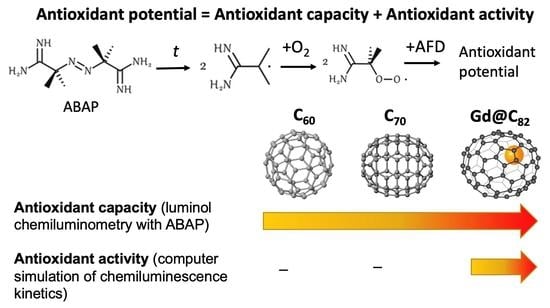Antioxidant Potential of Aqueous Dispersions of Fullerenes C60, C70, and Gd@C82
Abstract
:1. Introduction
2. Results
2.1. Assessment of the Antioxidant Capacity of AFDs
2.2. Antioxidant Activity (Chemiluminescence Kinetics before Antioxidant Depletion)
3. Discussion
4. Materials and Methods
4.1. Aqueous Fullerene Dispersion Preparation
4.2. Techniques and Reagents
4.3. Equipment
4.4. Computer Simulation and Data Handling
5. Conclusions
Supplementary Materials
Author Contributions
Funding
Institutional Review Board Statement
Informed Consent Statement
Data Availability Statement
Acknowledgments
Conflicts of Interest
References
- Colvin, V.L. The potential environmental impact of engineered nanomaterials. Nat. Biotechnol. 2003, 21, 1166–1170. [Google Scholar] [CrossRef] [PubMed]
- Chi, Y.; Bhonsle, J.B.; Canteenwala, T.; Huang, J.-P.; Shiea, J.; Chen, B.-J.; Chiang, L.Y. Novel Water-soluble Hexa(sulfobutyl)fullerenes as Potent Free Radical Scavengers. Chem. Lett. 1998, 27, 465–466. [Google Scholar] [CrossRef]
- Witte, P.; Beuerle, F.; Hartnagel, U.; Lebovitz, R.; Savouchkina, A.; Sali, S.; Guldi, D.; Chronakis, N.; Hirsch, A. Water solubility, antioxidant activity and cytochrome C binding of four families of exohedral adducts of C60 and C70. Org. Biomol. Chem. 2007, 5, 3599–3613. [Google Scholar] [CrossRef]
- Pellarini, F.; Pantarotto, D.; Da Ros, T.; Giangaspero, A.; Tossi, A.; Prato, M. A Novel [60]Fullerene Amino Acid for Use in Solid-Phase Peptide Synthesis. Org. Lett. 2001, 3, 1845–1848. [Google Scholar] [CrossRef]
- Cheng, F.; Yang, X.; Fan, C.; Zhu, H. Organophosphorus chemistry of fullerene: Synthesis and biological effects of organophosphorus compounds of C60. Tetrahedron 2001, 57, 7331–7335. [Google Scholar] [CrossRef]
- Kamat, J.P.; Devasagayam, T.P.; Priyadarsini, K.I.; Mohan, H. Reactive oxygen species mediated membrane damage induced by fullerene derivatives and its possible biological implications. Toxicology 2000, 155, 55–61. [Google Scholar] [CrossRef]
- Andrievsky, G.V.; Kosevich, M.V.; Vovk, O.M.; Shelkovsky, V.S.; Vashchenko, L.A. On the production of an aqueous colloidal solution of fullerenes. J. Chem. Soc. Chem. Commun. 1995, 1281–1282. [Google Scholar] [CrossRef]
- Andreev, S.; Purgina, D.; Bashkatova, E.; Garshev, A.; Maerle, A.; Andreev, I.; Osipova, N.; Shershakova, N.; Khaitov, M. Study of Fullerene Aqueous Dispersion Prepared by Novel Dialysis Method: Simple Way to Fullerene Aqueous Solution. Fuller. Nanotub. Carbon Nanostruct. 2014, 23, 792–800. [Google Scholar] [CrossRef]
- Isaacson, C.W.; Bouchard, D. Asymmetric flow field flow fractionation of aqueous C60 nanoparticles with size determination by dynamic light scattering and quantification by liquid chromatography atmospheric pressure photo-ionization mass spectrometry. J. Chromatogr. A 2010, 1217, 1506–1512. [Google Scholar] [CrossRef] [PubMed]
- Prylutskyy, Y.I.; Petrenko, V.I.; Ivankov, O.I.; Kyzyma, O.A.; Bulavin, L.A.; Litsis, O.O.; Evstigneev, M.P.; Cherepanov, V.V.; Naumovets, A.G.; Ritter, U. On the Origin of C60 Fullerene Solubility in Aqueous Solution. Langmuir 2014, 30, 3967–3970. [Google Scholar] [CrossRef]
- Pycke, B.F.G.; Halden, R.U.; Benn, T.M.; Westerhoff, P.; Herckes, P. Strategies for quantifying C60 fullerenes in environmental and biological samples and implications for studies in environmental health and ecotoxicology. TrAC Trends Anal. Chem. 2011, 30, 44–57. [Google Scholar] [CrossRef] [Green Version]
- Nel, A.E.; Mädler, L.; Velegol, D.; Xia, T.; Hoek, E.M.V.; Somasundaran, P.; Klaessig, F.; Castranova, V.; Thompson, M. Understanding biophysicochemical interactions at the nano-bio interface. Nat. Mater. 2009, 8, 543–557. [Google Scholar] [CrossRef] [PubMed]
- Johnston, H.J.; Hutchison, G.R.; Christensen, F.M.; Aschberger, K.; Stone, V. The Biological Mechanisms and Physicochemical Characteristics Responsible for Driving Fullerene Toxicity. Toxicol. Sci. 2009, 114, 162–182. [Google Scholar] [CrossRef] [PubMed] [Green Version]
- Sharoyko, V.V.; Ageev, S.V.; Podolsky, N.E.; Petrov, A.V.; Litasova, E.V.; Vlasov, T.D.; Vasina, L.V.; Murin, I.V.; Piotrovskiy, L.B.; Semenov, K.N. Biologically active water-soluble fullerene adducts: Das Glasperlenspiel (by H. Hesse)? J. Mol. Liq. 2021, 323, 114990. [Google Scholar] [CrossRef]
- Valgimigli, L.; Baschieri, A.; Amorati, R. Antioxidant activity of nanomaterials. J. Mater. Chem. B 2018, 6, 2036–2051. [Google Scholar] [CrossRef]
- Enes, R.F.; Tomé, A.C.; Cavaleiro, J.A.S.; Amorati, R.; Fumo, M.G.; Pedulli, G.F.; Valgimigli, L. Synthesis and Antioxidant Activity of [60]Fullerene–BHT Conjugates. Chem. Eur. J. 2006, 12, 4646–4653. [Google Scholar] [CrossRef]
- Czochara, R.; Kusio, J.; Litwinienko, G. Fullerene C60 conjugated with phenols as new hybrid antioxidants to improve the oxidative stability of polymers at elevated temperatures. RSC Adv. 2017, 7, 44021–44025. [Google Scholar] [CrossRef] [Green Version]
- Czochara, R.; Grajda, M.; Kusio, J.; Litwinienko, G. Expanding the antioxidant activity into higher temperatures—Fullerene C60 conjugated with α-Tocopherol analogue as a hybrid antioxidant in saturated lipid systems. Bulg. Chem. Commun. 2018, 50, 268–274. [Google Scholar]
- Yin, J.-J.; Lao, F.; Fu, P.P.; Wamer, W.G.; Zhao, Y.; Wang, P.C.; Qiu, Y.; Sun, B.; Xing, G.; Dong, J.; et al. The scavenging of reactive oxygen species and the potential for cell protection by functionalized fullerene materials. Biomaterials 2009, 30, 611–621. [Google Scholar] [CrossRef] [PubMed]
- Sachkova, A.S.; Kovel, E.S.; Churilov, G.N.; Guseynov, O.A.; Bondar, A.A.; Dubinina, I.A.; Kudryasheva, N.S. On mechanism of antioxidant effect of fullerenols. Biochem. Biophys. Rep. 2017, 9, 1–8. [Google Scholar] [CrossRef] [Green Version]
- Kovel, E.S.; Sachkova, A.S.; Vnukova, N.G.; Churilov, G.N.; Knyazeva, E.M.; Kudryasheva, N.S. Antioxidant Activity and Toxicity of Fullerenols via Bioluminescence Signaling: Role of Oxygen Substituents. Int. J. Mol. Sci. 2019, 20, 2324. [Google Scholar] [CrossRef] [Green Version]
- Eropkin, M.Y.; Melenevskaya, E.Y.; Nasonova, K.V.; Bryazzhikova, T.S.; Eropkina, E.M.; Danilenko, D.M.; Kiselev, O.I. Synthesis and Biological Activity of Fullerenols with Various Contents of Hydroxyl Groups. Pharm. Chem. J. 2013, 47, 87–91. [Google Scholar] [CrossRef]
- Zhou, S.; Yamamoto, M.; Briggs, G.A.D.; Imahori, H.; Porfyrakis, K. Probing the Dipolar Coupling in a Heterospin Endohedral Fullerene–Phthalocyanine Dyad. J. Am. Chem. Soc. 2016, 138, 1313–1319. [Google Scholar] [CrossRef]
- Hamblin, M.R. Fullerenes as photosensitizers in photodynamic therapy: Pros and cons. Photochem. Photobiol. Sci. 2018, 17, 1515–1533. [Google Scholar] [CrossRef] [PubMed]
- Tzirakis, M.D.; Orfanopoulos, M. Radical Reactions of Fullerenes: From Synthetic Organic Chemistry to Materials Science and Biology. Chem. Rev. 2013, 113, 5262–5321. [Google Scholar] [CrossRef]
- Mikheev, I.V.; Sozarukova, M.M.; Proskurnina, E.V.; Kareev, I.E.; Proskurnin, M.A. Non-Functionalized Fullerenes and Endofullerenes in Aqueous Dispersions as Superoxide Scavengers. Molecules 2020, 25, 2506. [Google Scholar] [CrossRef]
- Grebowski, J.; Konopko, A.; Krokosz, A.; DiLabio, G.A.; Litwinienko, G. Antioxidant activity of highly hydroxylated fullerene C60 and its interactions with the analogue of α-tocopherol. Free Radic. Biol. Med. 2020, 160, 734–744. [Google Scholar] [CrossRef] [PubMed]
- Shinohara, N.; Matsumoto, T.; Gamo, M.; Miyauchi, A.; Endo, S.; Yonezawa, Y.; Nakanishi, J. Is Lipid Peroxidation Induced by the Aqueous Suspension of Fullerene C60 Nanoparticles in the Brains of Cyprinus carpio? Environ. Sci. Technol. 2008, 43, 948–953. [Google Scholar] [CrossRef] [PubMed]
- Prylutska, S.V.; Grynyuk, I.I.; Matyshevska, O.P.; Prylutskyy, Y.I.; Ritter, U.; Scharff, P. Anti-oxidant Properties of C60 Fullerenes in vitro. Fuller. Nanotub. Carbon Nanostruct. 2008, 16, 698–705. [Google Scholar] [CrossRef]
- Mikheev, I.V.; Pirogova, M.O.; Usoltseva, L.O.; Uzhel, A.S.; Bolotnik, T.A.; Kareev, I.E.; Bubnov, V.P.; Lukonina, N.S.; Volkov, D.S.; Goryunkov, A.A.; et al. Green and rapid preparation of long-term stable aqueous dispersions of fullerenes and endohedral fullerenes: The pros and cons of an ultrasonic probe. Ultrason. Sonochem. 2021, 73, 105533. [Google Scholar] [CrossRef] [PubMed]
- Wang, C.; Lin, Y.; Wang, Y.; Liang, Y.; Meng, L.; Zhang, J.; Zhou, Q.; Jiang, G. Induced temperature-dependent DNA degradation by C60 without photoactivation. Chin. Sci. Bull. 2011, 56, 3100–3107. [Google Scholar] [CrossRef] [Green Version]
- Wang, I.C.; Tai, L.A.; Lee, D.D.; Kanakamma, P.P.; Shen, C.K.-F.; Luh, T.-Y.; Cheng, C.H.; Hwang, K.C. C60 and Water-Soluble Fullerene Derivatives as Antioxidants against Radical-Initiated Lipid Peroxidation. J. Med. Chem. 1999, 42, 4614–4620. [Google Scholar] [CrossRef] [PubMed]
- Skulachev, M.V.; Antonenko, Y.N.; Anisimov, V.N.; Chernyak, B.V.; Cherepanov, D.A.; Chistyakov, V.A.; Egorov, M.V.; Kolosova, N.G.; Korshunova, G.A.; Lyamzaev, K.G.; et al. Mitochondrial-Targeted Plastoquinone Derivatives. Effect on Senescence and Acute Age-Related Pathologies. Curr. Drug Targets 2011, 12, 800–826. [Google Scholar] [CrossRef]
- Chistyakov, V.A.; Smirnova, Y.O.; Prazdnova, E.V.; Soldatov, A.V. Possible Mechanisms of Fullerene C60 Antioxidant Action. BioMed Res. Int. 2013, 2013, 821498. [Google Scholar] [CrossRef] [Green Version]
- Prylutska, S.V.; Matyshevska, O.P.; Grynyuk, I.I.; Prylutskyy, Y.I.; Ritter, U.; Scharff, P. Biological Effects of C60 Fullerenes in vitro and in a Model System. Mol. Cryst. Liq. Cryst. 2007, 468, 265/[617]–274/[626]. [Google Scholar] [CrossRef]
- Zeynalov, E.B.; Allen, N.S.; Salmanova, N.I. Radical scavenging efficiency of different fullerenes C60–C70 and fullerene soot. Polym. Degrad. Stab. 2009, 94, 1183–1189. [Google Scholar] [CrossRef]
- Bulgakov, R.G.; Ponomareva, Y.G.; Maslennikov, S.I.; Nevyadovsky, E.Y.; Antipina, S.V. Inertness of C60 fullerene toward RO2• peroxy radicals. Russ. Chem. Bull. 2005, 54, 1862–1865. [Google Scholar] [CrossRef]
- Lissi, E.; Salim-Hanna, M.; Pascual, C.; del Castillo, M.D. Evaluation of total antioxidant potential (TRAP) and total antioxidant reactivity from luminol-enhanced chemiluminescence measurements. Free Radic. Biol. Med. 1995, 18, 153–158. [Google Scholar] [CrossRef]
- Magin, D.V.; Izmaĭlov, D.I.; Popov, I.N.; Levin, G.; Vladimirov, I.A. Photochemiluminescent study of the antioxidant activity in biological systems. Mathematical modeling. Vopr. Med. Khimii 2000, 46, 419–425. [Google Scholar]
- Vladimirov, Y.A.; Proskurnina, E.V.; Izmajlov, D.Y. Kinetic chemiluminescence as a method for study of free radical reactions. Biophysics 2011, 56, 1055–1062. [Google Scholar] [CrossRef]
- Sozarukova, M.M.; Shestakova, M.A.; Teplonogova, M.A.; Izmailov, D.Y.; Proskurnina, E.V.; Ivanov, V.K. Quantification of Free Radical Scavenging Properties and SOD-Like Activity of Cerium Dioxide Nanoparticles in Biochemical Models. Russ. J. Inorg. Chem. 2020, 65, 597–605. [Google Scholar] [CrossRef]
- Brainina, K.; Stozhko, N.; Vidrevich, M. Antioxidants: Terminology, Methods, and Future Considerations. Antioxidants 2019, 8, 297. [Google Scholar] [CrossRef] [PubMed] [Green Version]
- Apak, R.; Gorinstein, S.; Böhm, V.; Schaich, K.M.; Özyürek, M.; Güçlü, K. Methods of measurement and evaluation of natural antioxidant capacity/activity (IUPAC Technical Report). Pure Appl. Chem. 2013, 85, 957–998. [Google Scholar] [CrossRef] [Green Version]
- Proskurnina, E.V.; Izmailov, D.Y.; Sozarukova, M.M.; Zhuravleva, T.A.; Leneva, I.A.; Poromov, A.A. Antioxidant Potential of Antiviral Drug Umifenovir. Molecules 2020, 25, 1577. [Google Scholar] [CrossRef] [Green Version]
- Boulebd, H. Comparative study of the radical scavenging behavior of ascorbic acid, BHT, BHA and Trolox: Experimental and theoretical study. J. Mol. Struct. 2020, 1201, 127210. [Google Scholar] [CrossRef]
- Lissi, E.; Pascual, C.; Del Castillo, M.D. Luminol Luminescence Induced by 2,2′-Azo-Bis(2-Amidinopropane) Thermolysis. Free Radic. Res. Commun. 1992, 17, 299–311. [Google Scholar] [CrossRef] [PubMed]
- Jian, C.; Yan, J.; Zhang, H.; Zhu, J. Recent advances of small molecule fluorescent probes for distinguishing monoamine oxidase-A and monoamine oxidase-B in vitro and in vivo. Mol. Cell. Probes 2021, 55, 101686. [Google Scholar] [CrossRef] [PubMed]
- Gharbi, N.; Pressac, M.; Hadchouel, M.; Szwarc, H.; Wilson, S.R.; Moussa, F. [60]Fullerene is a Powerful Antioxidant In Vivo with No Acute or Subacute Toxicity. Nano Lett. 2005, 5, 2578–2585. [Google Scholar] [CrossRef]
- Catalan, J.; Elguero, J. Fluorescence of fullerenes (C60 and C70). J. Am. Chem. Soc. 1993, 115, 9249–9252. [Google Scholar] [CrossRef]
- Campbell, K.; Zappas, A.; Bunz, U.; Thio, Y.S.; Bucknall, D.G. Fluorescence quenching of a poly(para-phenylene ethynylenes) by C60 fullerenes. J. Photochem. Photobiol. A Chem. 2012, 249, 41–46. [Google Scholar] [CrossRef]
- Liu, B.-M.; Zhang, J.; Hao, A.-J.; Xu, L.; Wang, D.; Ji, H.; Sun, S.-J.; Chen, B.-Q.; Liu, B. The increased binding affinity of curcumin with human serum albumin in the presence of rutin and baicalin: A potential for drug delivery system. Spectrochim. Acta Mol. Biomol. Spectrosc. 2016, 155, 88–94. [Google Scholar] [CrossRef] [PubMed]
- Roy, P.; Bag, S.; Chakraborty, D.; Dasgupta, S. Exploring the Inhibitory and Antioxidant Effects of Fullerene and Fullerenol on Ribonuclease A. ACS Omega 2018, 3, 12270–12283. [Google Scholar] [CrossRef] [Green Version]
- Liu, X.; Ying, X.; Li, Y.; Yang, H.; Hao, W.; Yu, M. Identification differential behavior of Gd@C82(OH)22 upon interaction with serum albumin using spectroscopic analysis. Spectrochim. Acta Mol. Biomol. Spectrosc. 2018, 203, 383–396. [Google Scholar] [CrossRef]
- Sluch, M.; Samuel, I.; Petty, M. Quenching of pyrene fluorescence by fullerene C60 in Langmuir–Blodgett films. Chem. Phys. Lett. 1997, 280, 315–320. [Google Scholar] [CrossRef]
- Mchedlov-Petrossyan, N.O. Fullerenes in Liquid Media: An Unsettling Intrusion into the Solution Chemistry. Chem. Rev. 2013, 113, 5149–5193. [Google Scholar] [CrossRef] [PubMed]
- Zakharova, A.V.; Bedrina, M.E. A quantum chemical study of endometallofullerenes: Gd@C70, Gd@C82, Gd@C84, and Gd@C90. Eur. Phys. J. D 2020, 74, 116. [Google Scholar] [CrossRef]
- Compagnon, I.; Antoine, R.; Broyer, M.; Dugourd, P.; Lermé, J.; Rayane, D. Electric polarizability of isolated C70 molecules. Phys. Rev. A 2001, 64, 025201. [Google Scholar] [CrossRef]
- Bulgakov, R.G.; Galimov, D.I.; Sabirov, D.S. New property of the fullerenes: The anomalously effective quenching of electronically excited states owing to energy transfer to the C70 and C60 molecules. JETP Lett. 2007, 85, 632–635. [Google Scholar] [CrossRef]
- Wang, Z.; Lu, Z.-H.; Zhao, Y.; Gao, X. Oxidation-induced water-solubilization and chemical functionalization of fullerenes C60, Gd@C60 and Gd@C82: Atomistic insights into the formation mechanisms and structures of fullerenols synthesized by different methods. Nanoscale 2015, 7, 2914–2925. [Google Scholar] [CrossRef]
- Andrade, E.-B.; Martínez, A. Free radical scavenger properties of metal-fullerenes: C60 and C82 with Cu, Ag and Au (atoms and tetramers). Comput. Theor. Chem. 2017, 1115, 127–135. [Google Scholar] [CrossRef]
- Furukawa, K.; Okubo, S.; Kato, H.; Shinohara, H.; Kato, T. High-Field/High-Frequency ESR Study of Gd@C82-I. J. Phys. Chem. A 2003, 107, 10933–10937. [Google Scholar] [CrossRef]
- Fang, H.; Cong, H.; Suzuki, M.; Bao, L.; Yu, B.; Xie, Y.; Mizorogi, N.; Olmstead, M.M.; Balch, A.L.; Nagase, S.; et al. Regioselective Benzyl Radical Addition to an Open-Shell Cluster Metallofullerene. Crystallographic Studies of Cocrystallized Sc3C2@Ih-C80 and Its Singly Bonded Derivative. J. Am. Chem. Soc. 2014, 136, 10534–10540. [Google Scholar] [CrossRef] [PubMed]
- Guha, S.; Nakamoto, K. Electronic structures and spectral properties of endohedral fullerenes. Coord. Chem. Rev. 2005, 249, 1111–1132. [Google Scholar] [CrossRef]
- Ghiassi, K.B.; Olmstead, M.M.; Balch, A.L. Gadolinium-containing endohedral fullerenes: Structures and function as magnetic resonance imaging (MRI) agents. Dalton Trans. 2014, 43, 7346–7358. [Google Scholar] [CrossRef]
- Bubnov, V.P.; Laukhina, E.E.; Kareev, I.E.; Koltover, V.K.; Prokhorova, T.G.; Yagubskii, E.B.; Kozmin, Y.P. Endohedral Metallofullerenes: A Convenient Gram-Scale Preparation. Chem. Mater. 2002, 14, 1004–1008. [Google Scholar] [CrossRef]
- Buck, R.P.; Rondinini, S.; Covington, A.K.; Baucke, F.G.K.; Brett, C.M.A.; Camoes, M.F.; Milton, M.J.T.; Mussini, T.; Naumann, R.; Pratt, K.W.; et al. Measurement of pH. Definition, standards, and procedures (IUPAC Recommendations 2002). Pure Appl. Chem. 2002, 74, 2169–2200. [Google Scholar] [CrossRef] [Green Version]

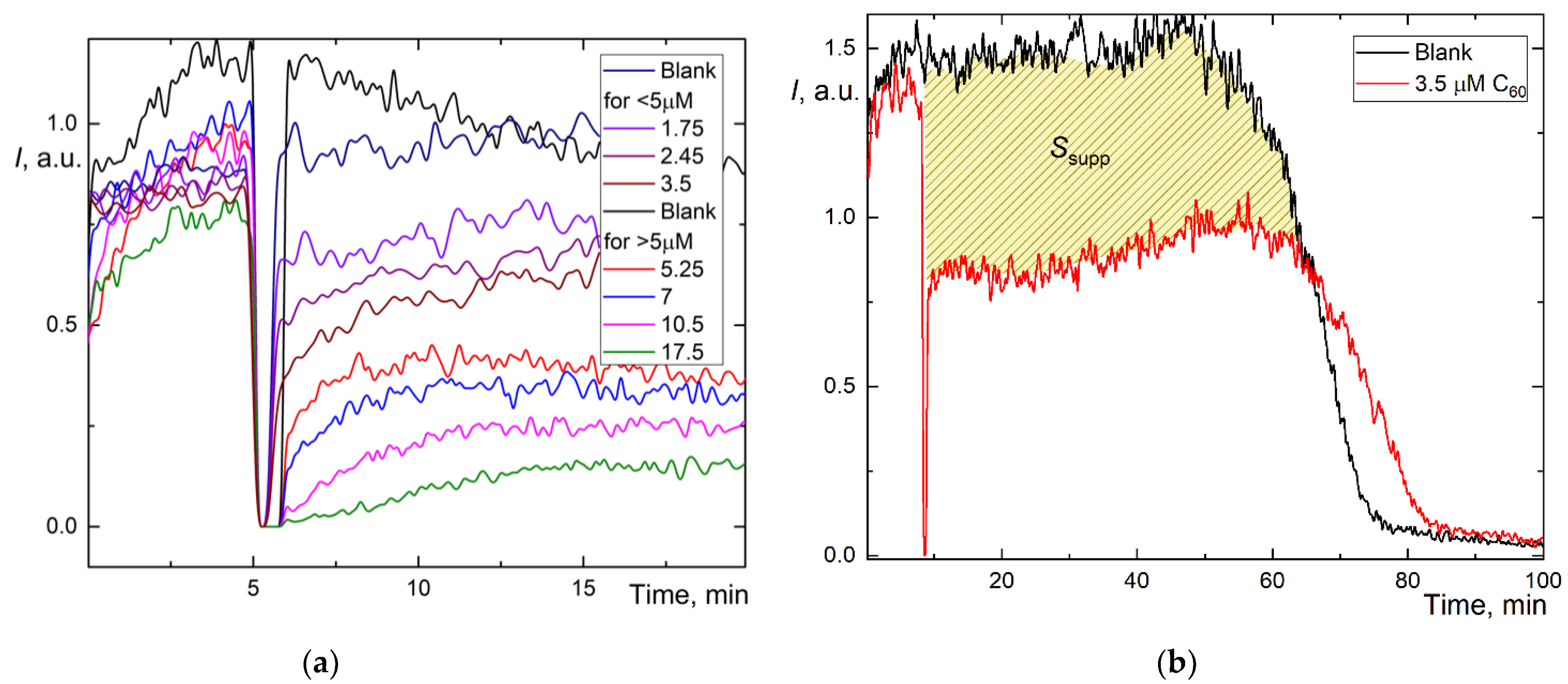
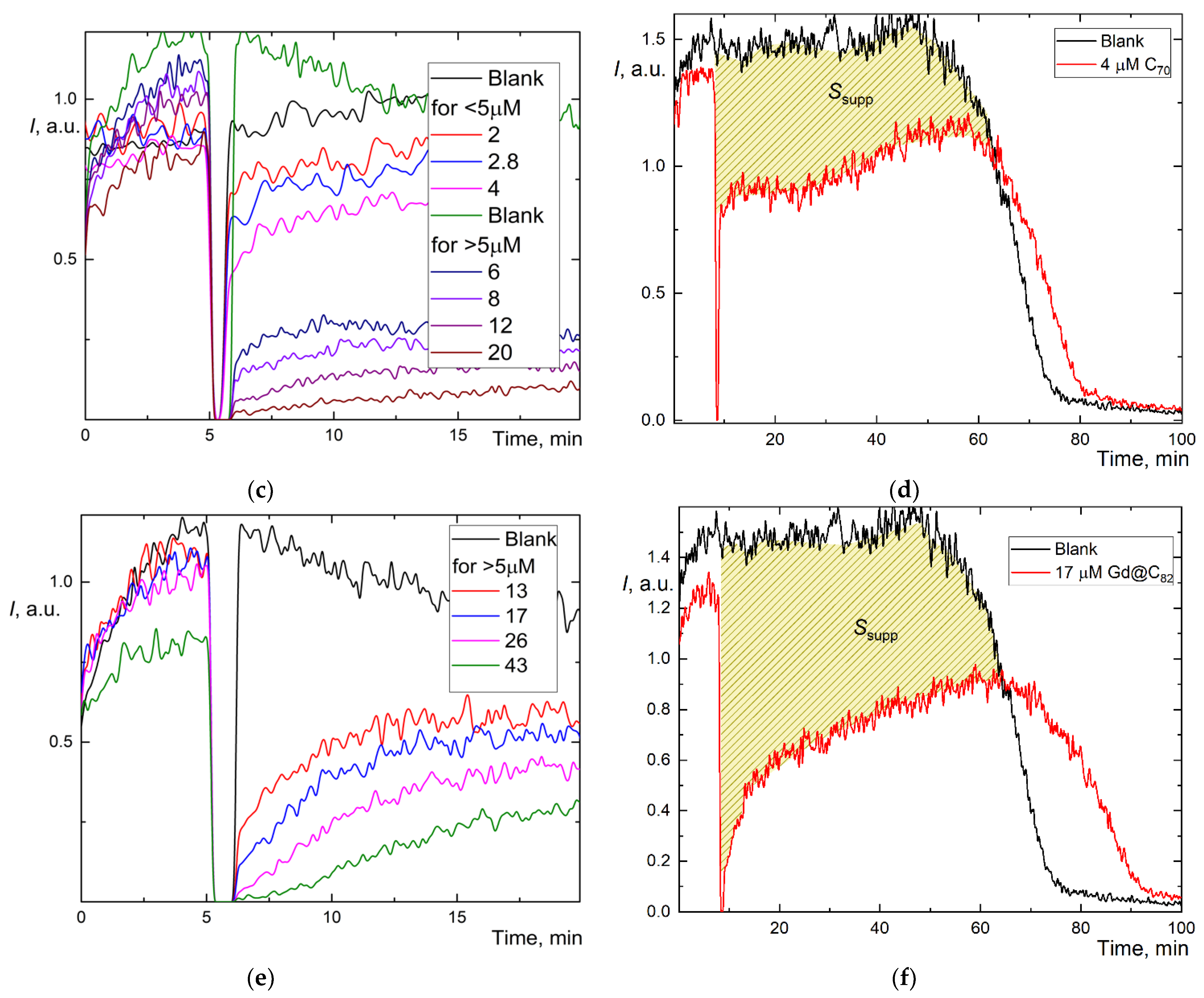
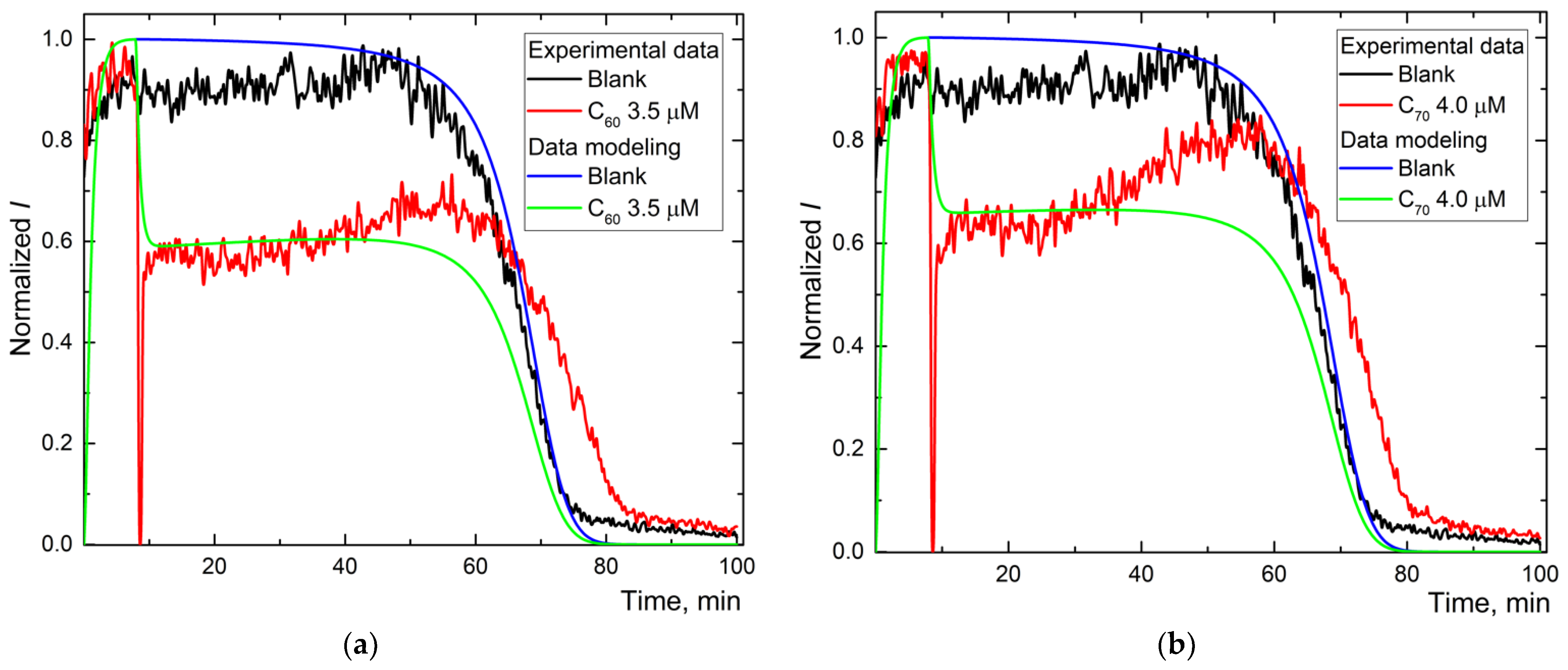
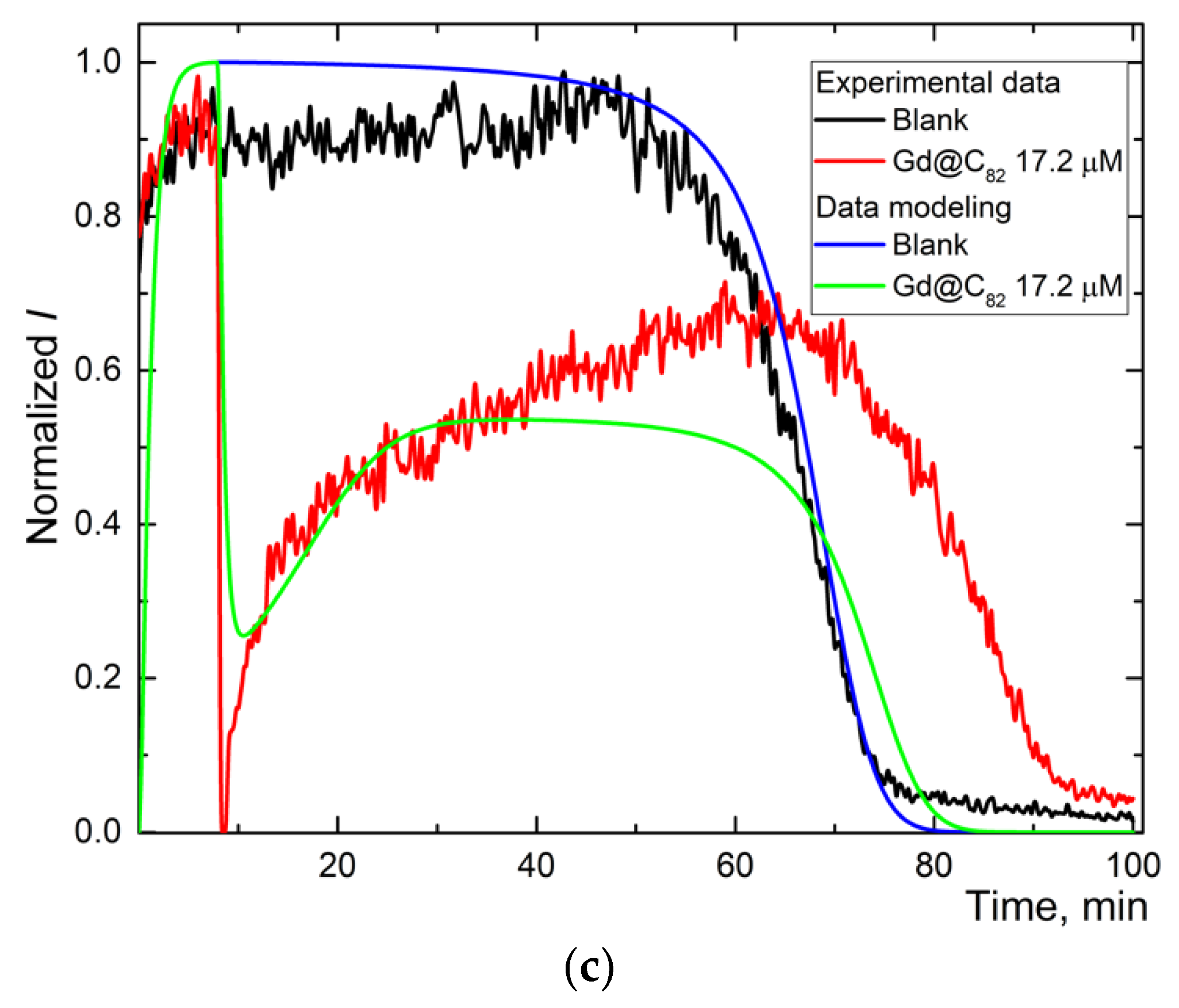
| AFD | Concentration Range, μM | TRAP | Suppression Area for the First 20 min, Linear Fit | ||
|---|---|---|---|---|---|
| Normalized Ssupp × 10–6 | Trolox Equivalent, µM | ||||
| C60 | 1.8 ÷ 18 | 0.51 | 0.31 | S20 = (76 ± 6) × cFul, r = 0.9955 | 6.4 ± 0.3 |
| C70 | 2.0 ÷ 20 | 0.29 | 0.18 | S20 = (46 ± 2) × cFul, r = 0.9956 | 11.0 ± 0.4 |
| Gd@C82 | 4.0 ÷ 40 | 0.12 | 0.072 | S20 = (28 ± 5) × cFul, r = 0.9754 | 22.6 ± 0.8 |
| Initial Concentrations, μM | C60 | C70 | Gd@C82 | Trolox® | Reaction |
|---|---|---|---|---|---|
| AO | 3.5 | 4.0 | 17.2 | 0, 0.1, and 0.2 | Quenching reaction (3a) |
| AO | n/a | n/a | 0.172 | n/a | Radical interception reaction (3) |
| Value of Simulated Constant, μM−1 min−1 | |||||
| ABAP → R | 1.25 | 1.70 | ABAP decomposition (1) | ||
| R + Lum → RLum* | 2 | Formation of an excited product (2) | |||
| RLum* → P + | 1 | 4 | Luminescence (2a) | ||
| AO + R• → … | n/a | n/a | 30 | 10,000 | Radical interception reaction (3) |
| AO + RLum* → … | 0.20 | 0.13 | 0.13 | n/a | Quenching reaction (3a) |
Publisher’s Note: MDPI stays neutral with regard to jurisdictional claims in published maps and institutional affiliations. |
© 2021 by the authors. Licensee MDPI, Basel, Switzerland. This article is an open access article distributed under the terms and conditions of the Creative Commons Attribution (CC BY) license (https://creativecommons.org/licenses/by/4.0/).
Share and Cite
Mikheev, I.V.; Sozarukova, M.M.; Izmailov, D.Y.; Kareev, I.E.; Proskurnina, E.V.; Proskurnin, M.A. Antioxidant Potential of Aqueous Dispersions of Fullerenes C60, C70, and Gd@C82. Int. J. Mol. Sci. 2021, 22, 5838. https://doi.org/10.3390/ijms22115838
Mikheev IV, Sozarukova MM, Izmailov DY, Kareev IE, Proskurnina EV, Proskurnin MA. Antioxidant Potential of Aqueous Dispersions of Fullerenes C60, C70, and Gd@C82. International Journal of Molecular Sciences. 2021; 22(11):5838. https://doi.org/10.3390/ijms22115838
Chicago/Turabian StyleMikheev, Ivan V., Madina M. Sozarukova, Dmitry Yu. Izmailov, Ivan E. Kareev, Elena V. Proskurnina, and Mikhail A. Proskurnin. 2021. "Antioxidant Potential of Aqueous Dispersions of Fullerenes C60, C70, and Gd@C82" International Journal of Molecular Sciences 22, no. 11: 5838. https://doi.org/10.3390/ijms22115838





